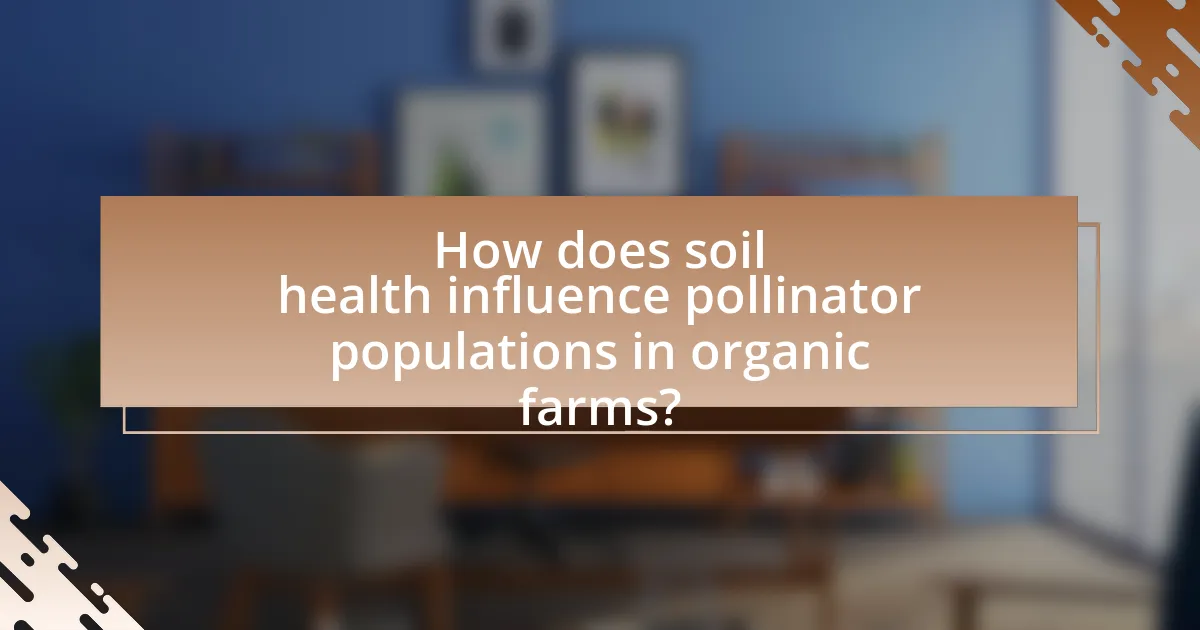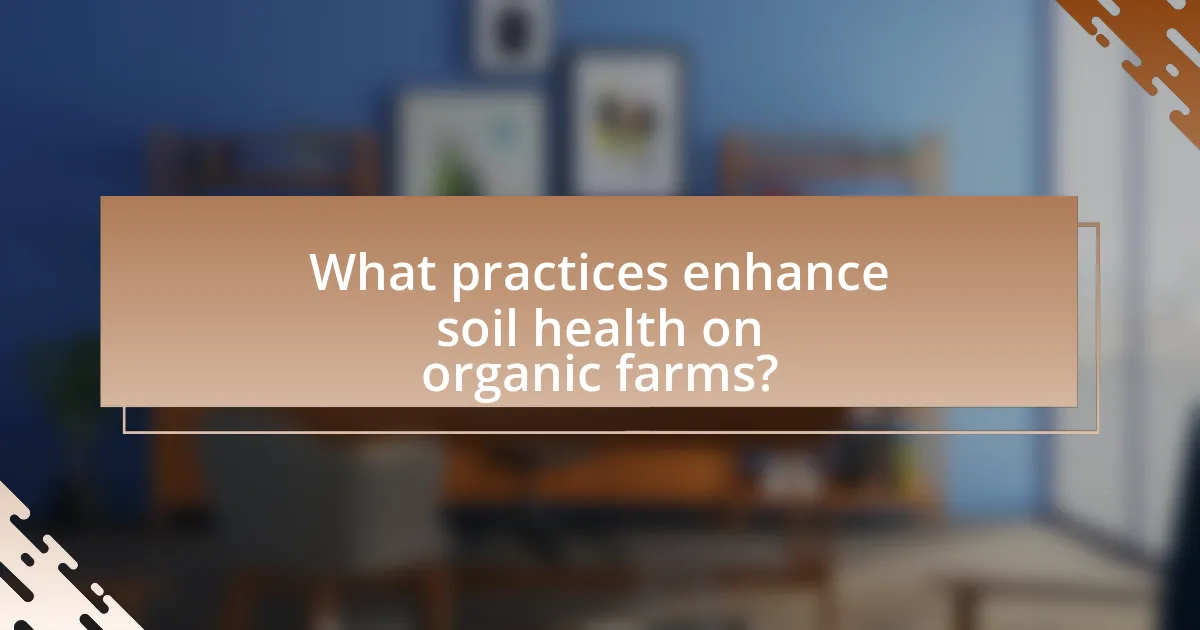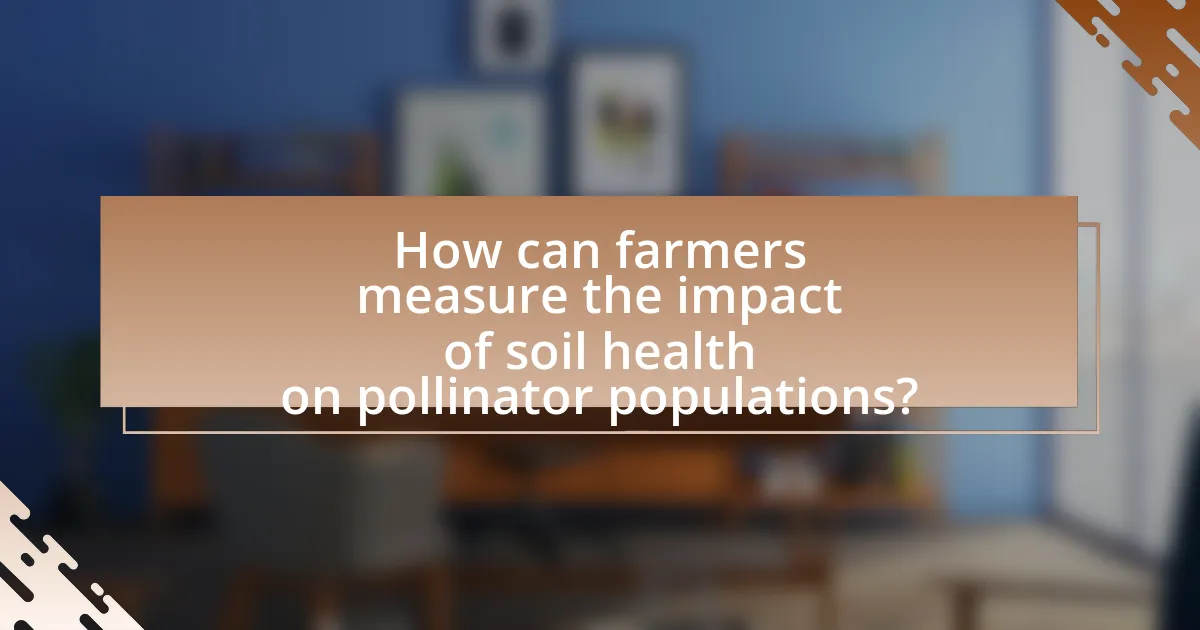Soil health is a critical factor influencing pollinator populations in organic farms, as it enhances plant diversity and productivity, providing essential food resources for pollinators. Key components of soil health include organic matter, structure, nutrient availability, biological activity, and water retention, all of which contribute to robust plant growth and attract pollinators. Practices such as crop rotation, cover cropping, and organic amendments improve soil health, thereby supporting diverse habitats for pollinators. The article explores the relationship between soil health and pollinator populations, highlighting the ecological benefits of maintaining healthy pollinator communities and the practices farmers can adopt to enhance both soil quality and pollinator habitats.

How does soil health influence pollinator populations in organic farms?
Soil health significantly influences pollinator populations in organic farms by enhancing plant diversity and productivity, which provide essential food resources for pollinators. Healthy soils support a variety of plants, including flowering species that attract bees and other pollinators. Research indicates that farms with improved soil health exhibit higher floral diversity, leading to increased visitation rates by pollinators. For instance, a study published in the journal “Agriculture, Ecosystems & Environment” found that organic farms with better soil management practices had 50% more pollinator visits compared to conventional farms. This correlation underscores the critical role of soil health in sustaining pollinator populations through the provision of diverse and abundant floral resources.
What are the key components of soil health?
The key components of soil health include soil organic matter, soil structure, nutrient availability, biological activity, and water retention. Soil organic matter enhances nutrient cycling and improves soil structure, which is crucial for root growth and water infiltration. Nutrient availability ensures that plants receive essential elements for growth, while biological activity, including microorganisms and earthworms, contributes to nutrient cycling and soil aeration. Water retention is vital for maintaining moisture levels, which supports plant health and, consequently, pollinator populations. Research indicates that healthy soils can lead to increased biodiversity, which benefits pollinators by providing diverse habitats and food sources.
How do nutrients in soil affect plant growth and pollinator attraction?
Nutrients in soil significantly influence plant growth and pollinator attraction. Adequate levels of essential nutrients, such as nitrogen, phosphorus, and potassium, promote robust plant development, leading to healthier foliage and flowers. Healthy plants produce more nectar and pollen, which are critical food sources for pollinators like bees and butterflies. Research indicates that plants with higher nutrient availability can enhance floral traits, such as color and scent, which attract more pollinators. For instance, a study published in the journal “Ecological Applications” found that increased soil fertility correlated with greater pollinator visitation rates, demonstrating the direct link between nutrient-rich soil, plant vitality, and pollinator activity.
What role does soil structure play in supporting diverse plant life?
Soil structure plays a critical role in supporting diverse plant life by influencing root development, water retention, and nutrient availability. A well-structured soil, characterized by aggregates that create pore spaces, allows roots to penetrate deeply, facilitating access to water and nutrients essential for plant growth. Research indicates that soils with good structure enhance microbial activity, which in turn improves nutrient cycling and availability, further supporting plant diversity. For instance, studies have shown that diverse plant communities thrive in soils with optimal structure, as they can better compete for resources and adapt to environmental changes.
Why are pollinators important for organic farming?
Pollinators are crucial for organic farming because they enhance crop yields and improve the quality of fruits and vegetables. In organic systems, where synthetic pesticides and fertilizers are avoided, pollinators like bees and butterflies play a vital role in the fertilization of flowering plants, leading to increased production. Research indicates that approximately 75% of the world’s flowering plants depend on animal pollinators, which directly impacts the diversity and abundance of crops grown organically. Furthermore, healthy soil supports diverse plant life, which in turn attracts and sustains pollinator populations, creating a symbiotic relationship that benefits both the ecosystem and agricultural productivity.
How do pollinators contribute to crop yields in organic farms?
Pollinators significantly enhance crop yields in organic farms by facilitating the process of pollination, which is essential for the reproduction of many flowering plants. Studies indicate that crops such as fruits, vegetables, and nuts rely heavily on pollinators for successful fruit set and seed production. For instance, research published in the journal “Agriculture, Ecosystems & Environment” shows that farms with higher pollinator diversity can experience yield increases of up to 30% compared to those with fewer pollinators. This relationship underscores the critical role that healthy pollinator populations play in maximizing the productivity of organic farming systems.
What are the ecological benefits of maintaining healthy pollinator populations?
Maintaining healthy pollinator populations provides essential ecological benefits, including enhanced plant reproduction and increased biodiversity. Pollinators, such as bees and butterflies, are responsible for the fertilization of approximately 75% of flowering plants, which directly contributes to the production of fruits, seeds, and nuts. This process not only supports food webs but also promotes genetic diversity among plant species, which is crucial for ecosystem resilience. Furthermore, healthy pollinator populations help sustain habitats for various wildlife, as diverse plant life creates environments that support a wide range of organisms. Studies indicate that areas with robust pollinator communities exhibit higher levels of plant diversity, which in turn fosters healthier ecosystems.

What practices enhance soil health on organic farms?
Practices that enhance soil health on organic farms include crop rotation, cover cropping, composting, and reduced tillage. Crop rotation improves soil structure and nutrient availability by alternating different crops, which helps prevent pest and disease buildup. Cover cropping adds organic matter and enhances soil fertility while preventing erosion. Composting enriches soil with nutrients and beneficial microorganisms, promoting a healthy ecosystem. Reduced tillage minimizes soil disturbance, preserving soil structure and microbial communities. These practices collectively contribute to improved soil health, which is essential for supporting diverse pollinator populations on organic farms.
How does crop rotation impact soil health and pollinator habitats?
Crop rotation enhances soil health and supports pollinator habitats by improving soil structure, nutrient availability, and biodiversity. The practice of alternating different crops in a specific sequence helps prevent soil degradation, reduces pest and disease cycles, and increases organic matter, which contributes to healthier soil ecosystems. Research indicates that diverse crop rotations can lead to higher soil microbial diversity, which is crucial for nutrient cycling and soil fertility. Additionally, varied crops provide a range of flowering plants that attract and sustain pollinators, thereby enhancing their habitats. Studies show that farms employing crop rotation practices often report increased pollinator abundance and diversity, which is vital for effective pollination services in agricultural systems.
What specific crops are beneficial for both soil health and pollinators?
Cover crops such as clover, vetch, and buckwheat are beneficial for both soil health and pollinators. These crops improve soil structure and fertility through nitrogen fixation and organic matter addition, while also providing essential nectar and pollen resources for pollinators. Research indicates that clover can increase soil nitrogen levels by up to 200 pounds per acre, enhancing soil health, while buckwheat attracts a variety of pollinators, including bees and butterflies, due to its abundant flowering.
How can cover crops improve soil quality and support pollinators?
Cover crops improve soil quality by enhancing soil structure, increasing organic matter, and promoting nutrient cycling. These benefits lead to better water retention and reduced erosion, which create a healthier environment for both soil organisms and plants. Additionally, cover crops provide habitat and food sources for pollinators, such as bees and butterflies, by producing flowers that bloom at different times throughout the growing season. Research indicates that diverse cover crop mixtures can increase pollinator abundance and diversity, thereby supporting overall ecosystem health.
What role do organic amendments play in soil health?
Organic amendments significantly enhance soil health by improving its structure, fertility, and biological activity. These amendments, such as compost, manure, and cover crops, increase organic matter content, which in turn boosts nutrient availability and water retention. Research indicates that soils enriched with organic amendments exhibit higher microbial diversity and activity, which are crucial for nutrient cycling and overall soil ecosystem functioning. For instance, a study published in the journal “Soil Biology and Biochemistry” found that organic amendments can increase soil organic carbon levels by up to 30%, thereby promoting healthier soil environments that support diverse plant and pollinator communities.
How do compost and manure affect soil fertility and biodiversity?
Compost and manure significantly enhance soil fertility and biodiversity. Compost enriches soil with organic matter, improving nutrient availability and water retention, while manure adds essential nutrients like nitrogen, phosphorus, and potassium, which are vital for plant growth. Studies show that the application of compost can increase soil microbial diversity, which is crucial for nutrient cycling and overall soil health. For instance, research published in the journal “Soil Biology and Biochemistry” indicates that compost application can lead to a 30% increase in microbial biomass compared to untreated soil. Additionally, manure application has been linked to increased earthworm populations, which aerate the soil and contribute to nutrient cycling, further promoting biodiversity. Thus, both compost and manure play critical roles in enhancing soil fertility and fostering a diverse ecosystem.
What are the benefits of using natural fertilizers for soil health?
Natural fertilizers significantly enhance soil health by improving its structure, fertility, and microbial activity. These fertilizers, derived from organic materials like compost, manure, and plant residues, contribute essential nutrients such as nitrogen, phosphorus, and potassium, which are vital for plant growth. Additionally, natural fertilizers promote the proliferation of beneficial microorganisms, which play a crucial role in nutrient cycling and soil aeration. Research indicates that soils treated with organic amendments can increase microbial biomass by up to 50%, leading to improved soil resilience and productivity. Furthermore, the use of natural fertilizers reduces the risk of chemical runoff, thereby protecting surrounding ecosystems and promoting biodiversity, which is essential for supporting pollinator populations in organic farms.

How can farmers measure the impact of soil health on pollinator populations?
Farmers can measure the impact of soil health on pollinator populations by assessing soil quality indicators and correlating them with pollinator diversity and abundance. Soil health can be evaluated through metrics such as organic matter content, nutrient levels, and microbial activity, which influence plant health and flowering patterns. Research indicates that improved soil health leads to increased plant diversity, which in turn supports a wider variety of pollinators. For instance, a study published in the journal “Ecological Applications” found that farms with higher soil organic matter had significantly greater pollinator visitation rates, demonstrating a direct link between soil health and pollinator populations.
What indicators can be used to assess soil health?
Indicators used to assess soil health include soil organic matter, soil pH, nutrient levels, microbial activity, and soil structure. Soil organic matter is crucial as it enhances nutrient retention and water-holding capacity, directly impacting plant growth and, consequently, pollinator habitats. Soil pH affects nutrient availability; for instance, a pH range of 6 to 7 is generally optimal for most crops. Nutrient levels, particularly nitrogen, phosphorus, and potassium, are essential for plant health and biodiversity. Microbial activity indicates biological health, as diverse microbial communities contribute to nutrient cycling and soil fertility. Lastly, soil structure influences aeration and water infiltration, which are vital for root development and overall ecosystem health. These indicators collectively provide a comprehensive assessment of soil health, which is critical for sustaining pollinator populations in organic farming systems.
How do soil tests help in understanding nutrient levels and microbial activity?
Soil tests provide critical insights into nutrient levels and microbial activity by analyzing soil composition and biological health. These tests measure essential nutrients such as nitrogen, phosphorus, and potassium, which are vital for plant growth and, consequently, for supporting pollinator populations. Additionally, soil tests assess microbial activity by evaluating the presence and diversity of soil microorganisms, which play a key role in nutrient cycling and organic matter decomposition. Research indicates that healthy microbial communities enhance soil fertility and plant health, thereby creating a more conducive environment for pollinators. For instance, a study published in the journal “Soil Biology and Biochemistry” found that soils with higher microbial diversity correlate with improved plant health and increased pollinator visits.
What methods can be used to monitor pollinator populations effectively?
Effective methods to monitor pollinator populations include direct observation, trapping, and citizen science initiatives. Direct observation involves systematically counting and identifying pollinators in specific areas, which provides real-time data on species presence and abundance. Trapping methods, such as using pan traps or malaise traps, capture pollinators for later identification and analysis, allowing researchers to assess diversity and population trends quantitatively. Citizen science initiatives engage the public in reporting pollinator sightings, which can significantly increase data collection across larger geographic areas. Studies have shown that combining these methods enhances the accuracy and reliability of pollinator monitoring, as evidenced by research conducted by the Xerces Society, which emphasizes the importance of diverse monitoring strategies to understand pollinator health and distribution.
What best practices can farmers adopt to improve soil health and support pollinators?
Farmers can adopt practices such as cover cropping, reduced tillage, and organic amendments to improve soil health and support pollinators. Cover cropping enhances soil structure and fertility while providing habitat and food for pollinators. Reduced tillage minimizes soil disturbance, preserving soil organisms essential for nutrient cycling and creating a more stable environment for pollinators. Organic amendments, like compost, enrich the soil with nutrients and improve its water retention capacity, fostering a healthier ecosystem that benefits both soil health and pollinator populations. Studies indicate that these practices can lead to increased biodiversity and improved crop yields, demonstrating their effectiveness in promoting sustainable agriculture.
How can farmers implement integrated pest management to protect pollinators?
Farmers can implement integrated pest management (IPM) to protect pollinators by utilizing a combination of biological control, habitat management, and targeted pesticide application. Biological control involves introducing natural predators or parasites to manage pest populations, thereby reducing the need for chemical pesticides that can harm pollinators. Habitat management includes planting diverse crops and maintaining flowering plants to provide food and nesting sites for pollinators, which enhances their populations. Targeted pesticide application focuses on using pesticides only when necessary and selecting those that are less harmful to pollinators, such as using systemic insecticides with lower toxicity to non-target species. Research indicates that these practices not only protect pollinators but also improve overall farm biodiversity and productivity.
What are the benefits of creating pollinator-friendly habitats on organic farms?
Creating pollinator-friendly habitats on organic farms enhances biodiversity and improves crop yields. These habitats provide essential resources such as food and nesting sites for pollinators, which are crucial for the pollination of many crops. Research indicates that farms with diverse plant species attract a greater variety of pollinators, leading to increased pollination services. For example, a study published in the journal “Agriculture, Ecosystems & Environment” found that farms with wildflower strips had up to 50% more pollinator visits compared to those without. This increase in pollinator activity directly correlates with higher fruit and seed set in crops, demonstrating the tangible benefits of fostering such habitats.










